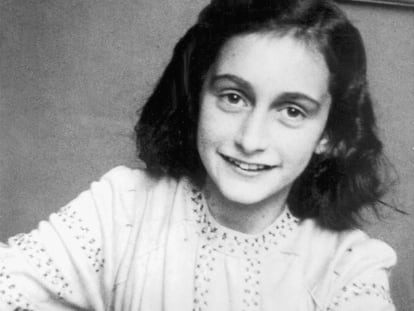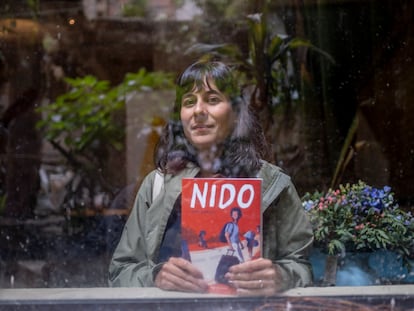Why does Anne Frank’s diary make people uneasy?
A German daycare center named for the famous Holocaust victim is changing its name, and a graphic novel based on the book was pulled from two US schools


The Diary of a Young Girl, often referred to as The Diary of Anne Frank, is perhaps the most famous memoir of the Holocaust. But Anne Frank’s legacy is currently being questioned both within and outside of Europe. A daycare center in Saxony Anhalt (northeastern Germany) named after Frank is considering a name change. The center’s director and the mayor prefer one that is free of political associations. They believe that Frank’s story of hiding from the Nazis for two years and tragically dying in a concentration camp at 15 may be hard for children to understand, especially due to the ongoing war in Gaza and the increase in antisemitic acts.
In the United States, the controversy over a graphic novel based on the most famous teenage diary of the 20th century is about its explicit allusions to sexuality. According to the American Library Association, book bans and attempts have increased in 2023 in both school and public libraries. One vignette of the graphic novel shows Frank walking among some naked statues. In others, she describes her genitals and offers to show her breasts to a friend. Such scenes have led schools to consider the book inappropriate for young teenagers. In September, a Texas teacher was fired for reading the book in class, while in Florida, the graphic novel was removed from a high school library last March.
Sexual references
Historian Kees Ribbens, a researcher with the NIOD Institute for War, Holocaust and Genocide Studies in Amsterdam, says removing references to nudity or sex in the context of the Holocaust is not driven by antisemitism, but rather by a disregard for the individuality of the victims. It also demonstrates a poor understanding of the Shoah (the Hebrew word for the Holocaust). “Six million people were systematically murdered, one by one, which contradicts the idealized image of certain individuals frozen in time. As we grow up, it’s only natural to question our identities and the changes in our bodies. Similarly, Anne Frank also had her own share of questions about herself and those around her. However, reducing them to stereotypes hinders a true understanding of the Holocaust victims as unique individuals,” said Ribbens.
Censoring Anne Frank’s book is noteworthy because the Holocaust is a required topic in U.S. schools. Consequently, only the illustrated version of her diary has been removed from classrooms. “Parents can appeal to a committee to voice their concerns regarding specific books in school libraries. But because of the internet, books are gradually becoming less of a source of knowledge for children,” said Bart Wallet, professor of Jewish Studies at the University of Amsterdam. Wallet says this is another manifestation of culture wars, and that there are “all kinds of attempts to purge libraries of anything that’s racist, colonialist, imperialist... Then there are far-right groups that want to ban sexually explicit books and those that discuss gender issues.”
Hans Wallage, an anti-Semitism researcher, says that the schools in Texas and Florida are isolated cases, and believes Anne Frank’s diary is a good way to teach adolescents “about the terrible suffering of Jews during World War II.” The Anne Frank House in Amsterdam also noted the popularity of graphic novels among young people and expressed disappointment over the “missed chance to introduce the Holocaust and Anne Frank’s story to new audiences” in the U.S. schools that banned the illustrated version.
Anne’s story
Otto Frank, Anne’s father, was the sole survivor of the family. Sadly, his wife, Edith, and his other daughter, Margot, did not come back from the concentration camps. The four others who were in hiding with them also did not return. When Anne’s father read the diary After the war, he felt uneasy about the parts where she discussed her physical changes and emotions. It is unclear whether he was uncomfortable with her thoughts on these matters or just the act of sharing them with the world. “In the 1980s, experts found content in the original manuscript that was missing from the published version, which was added to subsequent editions. The graphic novel’s authors relied on these more complete versions,” said Ribbens.
The graphic novel by Israeli filmmaker Ari Folman and illustrator David Polonsky was published in 2018 and translated into 30 languages. The pair later made it into an animated film called Where’s Anne Frank? It’s aimed at young teenagers about the same age as Anne, who began writing the diary when she was 13. In 1945, Frank died of typhus in the Bergen-Belsen concentration camp in northern Germany when she was 15.
Anne Frank “has become such an icon of humanism that you hardly notice the real girl,” said Wallet. “The authors of the graphic novel wanted to restore her humanity, and there are images that evangelicals consider too explicit.” It’s easy to overlook the passages about sexuality in the original text, written while Frank was experiencing puberty in the Amsterdam canal house where they hid from the Nazis. The diary was discovered in August 1944. “It’s not the first book where a teenager writes honestly and openly. Maybe the whole uproar in the United States is because she’s become the epitome of innocence and has this romantic aura around her,” said Kees Ribbens.
Yves Kugelmann, a board member of the Anne Frank Fund in Basel (Switzerland) that manages the rights to the book, says that the graphic novel adaptation was a very thorough process that involved Buddy Elias, Frank’s cousin and former president of the Fund who died in 2015. Kugelmann suggests that the removal of the graphic novel from schools is not primarily due to anti-Semitism, but rather a resistance to modernity that affects other books as well.
By sanctifying Anne Frank, we have reduced her. Real lives are much more complicatedKees Ribbens
Naomi Mestrum, director of the Documentation and Information Center Israel (CIDI), a Dutch organization dedicated to combatting antisemitism, believes the school bans are due to narrow-mindedness. “They seem to be pretty conservative, Christian and puritan places. In Europe, there have been some problems in schools regarding sexuality, but nothing related to Anne Frank.” Kees Ribbens said, “By sanctifying Anne Frank, we have reduced her. Real lives are much more complicated.” The Anne Frank House says The Diary of Young Girl has been translated into 70 languages.
Sign up for our weekly newsletter to get more English-language news coverage from EL PAÍS USA Edition
Tu suscripción se está usando en otro dispositivo
¿Quieres añadir otro usuario a tu suscripción?
Si continúas leyendo en este dispositivo, no se podrá leer en el otro.
FlechaTu suscripción se está usando en otro dispositivo y solo puedes acceder a EL PAÍS desde un dispositivo a la vez.
Si quieres compartir tu cuenta, cambia tu suscripción a la modalidad Premium, así podrás añadir otro usuario. Cada uno accederá con su propia cuenta de email, lo que os permitirá personalizar vuestra experiencia en EL PAÍS.
¿Tienes una suscripción de empresa? Accede aquí para contratar más cuentas.
En el caso de no saber quién está usando tu cuenta, te recomendamos cambiar tu contraseña aquí.
Si decides continuar compartiendo tu cuenta, este mensaje se mostrará en tu dispositivo y en el de la otra persona que está usando tu cuenta de forma indefinida, afectando a tu experiencia de lectura. Puedes consultar aquí los términos y condiciones de la suscripción digital.










































